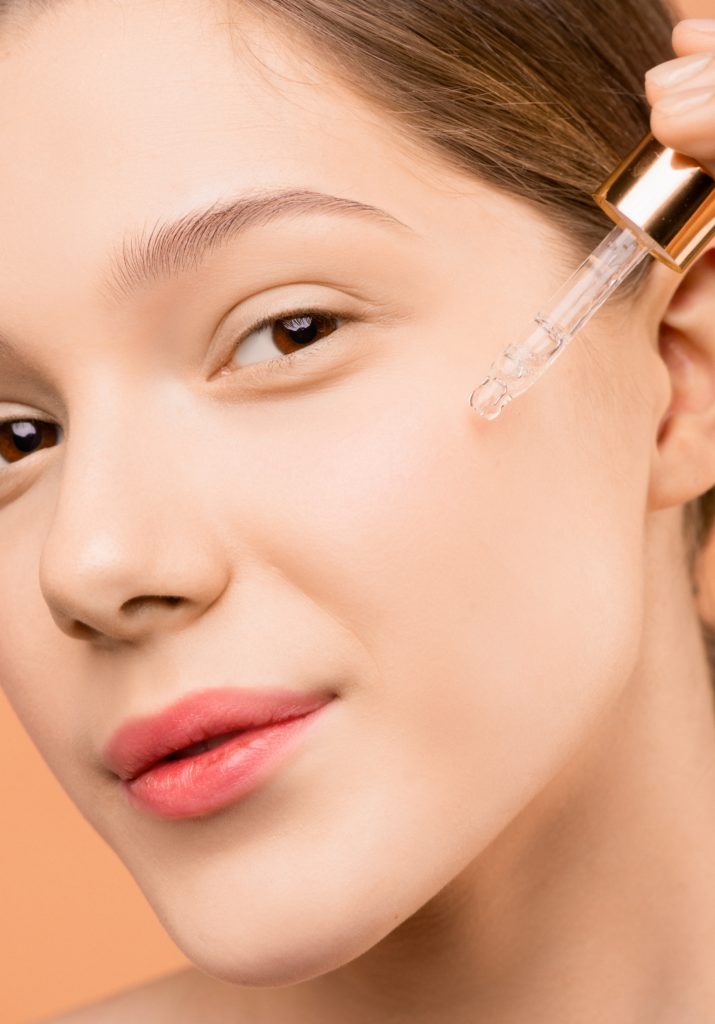I won’t hide the final answer: hyaluronic acid isn’t the new dermatology cure-all. Fortunately, there’s some evidence this ingredient might make a replenishing skin moisturizer.
It won’t solve all your skincare woes, but you might just fall in love with this hidden gem that’s gaining popularity these last years.
While hyaluronic acid can be dangerous at too high a concentration, the right formula may treat acne scar blemishes, reduce the appearance of fine lines, and hydrate dry skin.
I want to talk about how to use hyaluronic acid correctly, how it works, and what ingredients to avoid or seek out.
What is hyaluronic acid?
Hyaluronic acid (HA) is a natural humectant — simply put, a moisturizer. Your body already makes the stuff! It can be found in your connective tissue, skin, and eyes.
As a humectant, HA can hold 1,000 times its weight in water. This means when it’s applied to the face, HA draws in water and holds it there.
Factors such as age, sun exposure, or toxin exposure (like the chemical toxins in environmental pollutants) can reduce your ability to naturally create HA, at which point you may want to consider adding this hydrating skin care product to your routine.
Our HA levels can decrease from 100% to 5% from when we are children to when we are adults. Some would propose then that supplementing HA “should” have an anti-aging effect in this regard.
What does hyaluronic acid do for skin?
Hyaluronic acid molecules moisturize dry skin and hydrate acne-prone skin. Many have started using hyaluronic acid for acne, but HA should only constitute a part of your acne care routine.
Hyaluronic acid might also work for oily skin. Some 2017 research reveals that HA reduces sebum production (oil) in the skin while keeping skin moisturized.
Dermal Fillers vs. Topical Serum
Dermal fillers are injections that remove fine lines or have a skin-plumping effect. HA dermal fillers can even help reduce acne scars.
Because of an HA dermal filler’s ability to treat acne scars and moisturize skin, many call HA dermal fillers anti-aging.
Topical serums are formulations you apply to your skin. Topical hyaluronic acid for acne scars is less-researched than dermal fillers, but still has some potential benefits.
For instance, a 2017 study showed that topical HA improved the effectiveness of a fractional carbon dioxide laser acne scarring treatment, reduced the side effects, and accelerated the recovery time.
Does hyaluronic acid help with acne or acne scars?

However, there is a good amount of evidence that you can use hyaluronic acid for acne scars.
Here’s a 2018 study and a 2020 study confirming HA injections are safe and effective treatment for acne scars.
No surprise, research published in the Journal of Cosmetic Dermatology links topical HA with anti-aging and reduced wrinkles.
And 2019 research shows the promise of HA patches in anti-aging and hydration.
Can hyaluronic acid cause acne?
In rare cases, some may be allergic to a hyaluronic acid treatment, in which case it can cause or worsen an acne breakout. If possible, test a small amount first.
Just because HA is on the label doesn’t mean it’s a good product.
Hyaluronic acid is basically a good thing. But when additives and extra ingredients are added in, it can negate the benefits of hyaluronic acid.
Can hyaluronic acid irritate skin?
If a hyaluronic acid concentration is too high, it can irritate the skin. Aim for a 1% concentration of HA.
However, after consulting a dermatologist, if 1% concentration is too low, those with very dry skin types may want to look for a slightly higher concentration.
What are the side effects of using hyaluronic acid injectable fillers and topical solutions?
- If a HA dermal filler injection is used, some may experience redness, itching, bruising, or swelling that usually clears up within a week or so. This is likely due to the injection process, not the HA serum itself.
- In rare cases, some people may have an allergic reaction to an HA solution or some of it’s additives, resulting in irritation and even an acne breakout. If this occurs, stop usage immediately.
Always check the ingredient list on your hyaluronic acid serum.
Skincare ingredients can be tricky, even with a hyaluronic acid serum. It’s important to steer clear of dangerous chemicals and seek out the good stuff.
Avoid these harmful ingredients:
- Alcohol — It dries out the skin.
- Silicone — This traps dirt, sweat, and bacteria in your pores to create an artificial silky texture, but this is a quick fix that is harmful in the long run.
- Mineral oil — It clogs pores.
- Linseed oil — It clogs pores.
- Lanolin — This is often combined with irritating chemicals that harm sensitive skin.
- Sulphates — These irritate the skin and eyes. Some claim they contribute to hair loss or cancer, but the research behind that is lacking.
- Parabens — These may affect hormone levels and promote obesity.
There are some beneficial ingredients as well:
- Vitamin C — Vitamin C is an anti-inflammatory, anti-aging antioxidant. Vitamin C also seems to add a brightening effect to HA.
- Niacinamide — This evens skin tone and reduces redness. It is also an antioxidant.
- Retinol — It improves skin texture, increases hydration, and reduces fine lines.
- Ceramides — These help treat acne.
- Amino peptides — Collagen-like and collagen-enhancing peptides reduce wrinkles and de-age your skin.
How to Add Hyaluronic Acid to Your Routine
Hyaluronic acid works for moisturizing, treating acne scars, and skin hydration. But when people use hyaluronic acid for acne by itself, they are missing out on real results.
As with any new skincare product, do a test run on a small patch of skin to check for irritation or allergies.
When you are looking for products, you may see the term “sodium hyaluronate.” This is simply the salt of HA and exhibits basically the same benefits as HA.
HA should be used to enhance aging skin cells’ hydration and elasticity, as well as to treat acne scars. And combining it with ingredients like vitamin C, niacinamide, or retinol can promote overall healthy skin.
Most HA face serums consist of hyaluronic acid molecules that are too large to delve deeper than just the top layer of your skin. Recently, researchers have been able to reduce the size of their HA to the five nanometers required to permeate deeper levels of your skin. Fortunately, nano HA is already on the market! The potential benefits vs risks of nanotechnology based skin care products has yet to be determined.
In Summary
- Hyaluronic acid is a naturally-found skin moisturizer. As an adult, your body makes about 5% of the hyaluronic acid it did when you were a child. Using hyaluronic acid in your skincare routine should have an anti-aging effect.
- Research backs the claims that hyaluronic acid treats acne scars, dry skin, and oily skin.
- Avoid harmful ingredients like alcohol, silicone, and parabens. But look for these hyaluronic acid boosters: vitamin C, niacinamide, and retinol.
Sources
- Papakonstantinou, E., Roth, M., & Karakiulakis, G. (2012). Hyaluronic acid: A key molecule in skin aging. Dermato-endocrinology, 4(3), 253-258. Full text: https://www.ncbi.nlm.nih.gov/pmc/articles/PMC3583886/
- Pavicic, T., Gauglitz, G. G., Lersch, P., Schwach-Abdellaoui, K., Malle, B., Korting, H. C., & Farwick, M. (2011). Efficacy of cream-based novel formulations of hyaluronic acid of different molecular weights in anti-wrinkle treatment. Journal of drugs in dermatology: JDD, 10(9), 990-1000. Abstract: https://www.ncbi.nlm.nih.gov/pubmed/22052267
- Jung, Y. R., Hwang, C., Ha, J. M., Choi, D. K., Sohn, K. C., Lee, Y., … & Im, M. (2017). Hyaluronic acid decreases lipid synthesis in sebaceous glands. Journal of Investigative Dermatology, 137(6), 1215-1222. Full text: https://www.sciencedirect.com/science/article/pii/S0022202X17301082
- Halachmi, S., Ben, D. A., & Lapidoth, M. (2013). Treatment of acne scars with hyaluronic acid: an improved approach. Journal of drugs in dermatology: JDD, 12(7), e121-3. Partial text: https://jddonline.com/articles/dermatology/S1545961613E0121X/1
- Gold, M. H. (2007). Use of hyaluronic acid fillers for the treatment of the aging face. Clinical interventions in aging, 2(3), 369. Full text: https://www.ncbi.nlm.nih.gov/pmc/articles/PMC2685277/
- Alsaedy, S. J., Mosa, K. A., & Alshami, S. H. (2017). The efficacy of topical hyaluronic acid serum in acne scar patients treated with fractional CO2 laser. Am J Dermatol Venereol, 6, 17-24. Full text: http://article.sapub.org/10.5923.j.ajdv.20170602.01.html
- Dierickx, C., Larsson, M. K., & Blomster, S. (2018). Effectiveness and safety of acne scar treatment with nonanimal stabilized hyaluronic acid gel. Dermatologic Surgery, 44, S10-S18. Abstract: https://www.ncbi.nlm.nih.gov/pubmed/30358630
- Artzi, O., Cohen, S., Koren, A., Niv, R., & Friedman, O. (2019). Dual‐plane hyaluronic acid treatment for atrophic acne scars. Journal of cosmetic dermatology. Abstract: https://www.ncbi.nlm.nih.gov/pubmed/31074185
- Nobile, V., Buonocore, D., Michelotti, A., & Marzatico, F. (2014). Anti‐aging and filling efficacy of six types hyaluronic acid based dermo‐cosmetic treatment: double blind, randomized clinical trial of efficacy and safety. Journal of cosmetic dermatology, 13(4), 277-287. Full text: https://www.ncbi.nlm.nih.gov/pmc/articles/PMC4371636/
- Lee, Y. J., Kim, H. T., Lee, W. J., Chang, S. E., Lee, M. W., Choi, J. H., & Won, C. H. (2019). Anti‐aging and hydration efficacy of a cross‐linked hyaluronic acid microstructure patch. Dermatologic therapy, 32(3), e12888. Abstract: https://www.ncbi.nlm.nih.gov/pubmed/30942947
- McKenzie, S. N., Turton, P., Castle, K., Clark, S. M., Lansdown, M. R., & Horgan, K. (2011). Alcohol hand abuse: a cross-sectional survey of skin complaints and usage patterns at a large UK teaching hospital. JRSM short reports, 2(8), 1-7. Full text: https://www.ncbi.nlm.nih.gov/pmc/articles/PMC3166264/
- Bondi, C. A., Marks, J. L., Wroblewski, L. B., Raatikainen, H. S., Lenox, S. R., & Gebhardt, K. E. (2015). Human and environmental toxicity of sodium lauryl sulfate (SLS): evidence for safe use in household cleaning products. Environmental health insights, 9, EHI-S31765. Full text: https://www.ncbi.nlm.nih.gov/pmc/articles/PMC4651417/
- Engeli, R. T., Rohrer, S. R., Vuorinen, A., Herdlinger, S., Kaserer, T., Leugger, S., … & Odermatt, A. (2017). Interference of paraben compounds with estrogen metabolism by inhibition of 17β-hydroxysteroid dehydrogenases. International journal of molecular sciences, 18(9), 2007. Full text: https://www.ncbi.nlm.nih.gov/pmc/articles/PMC5618656/
- Kolatorova, L., Sramkova, M., Vitku, J., Vcelak, J., Lischkova, O., Starka, L., & Duskova, M. (2018). Parabens and their relation to obesity. Physiological research, 67, S465-S472. Full text: https://pdfs.semanticscholar.org/52f4/3ce57ecb16bd2f0fed33da097b83eb8cb3be.pdf
- Al-Niaimi, F., & Chiang, N. Y. Z. (2017). Topical vitamin C and the skin: mechanisms of action and clinical applications. The Journal of clinical and aesthetic dermatology, 10(7), 14. Full text: https://www.ncbi.nlm.nih.gov/pmc/articles/PMC5605218/
- Levin, J., & Momin, S. B. (2010). How much do we really know about our favorite cosmeceutical ingredients?. The Journal of clinical and aesthetic dermatology, 3(2), 22. Full text: https://www.ncbi.nlm.nih.gov/pmc/articles/PMC2921764/
- Zasada, M., & Budzisz, E. (2019). Retinoids: active molecules influencing skin structure formation in cosmetic and dermatological treatments. Advances in Dermatology and Allergology/Postȩpy Dermatologii i Alergologii, 36(4), 392. Full text: https://www.ncbi.nlm.nih.gov/pmc/articles/PMC6791161/
- Lynde, C. W., Andriessen, A., Barankin, B., De Gannes, G., Gulliver, W., Haber, R., … & Toole, J. (2014). Moisturizers and ceramide-containing moisturizers may offer concomitant therapy with benefits. The Journal of clinical and aesthetic dermatology, 7(3), 18. Full text: https://www.ncbi.nlm.nih.gov/pmc/articles/PMC3970828/
- Schagen, S. K. (2017). Topical peptide treatments with effective anti-aging results. Cosmetics, 4(2), 16. Full text: https://clairderm.com/upload/images/Products/12/Research/Topical%20peptide%20treatment%20with%20effective%20anti%20aging%20results.pdf
- Jegasothy, S. M., Zabolotniaia, V., & Bielfeldt, S. (2014). Efficacy of a new topical nano-hyaluronic acid in humans. The Journal of clinical and aesthetic dermatology, 7(3), 27. Full text: https://www.ncbi.nlm.nih.gov/pmc/articles/PMC3970829/



